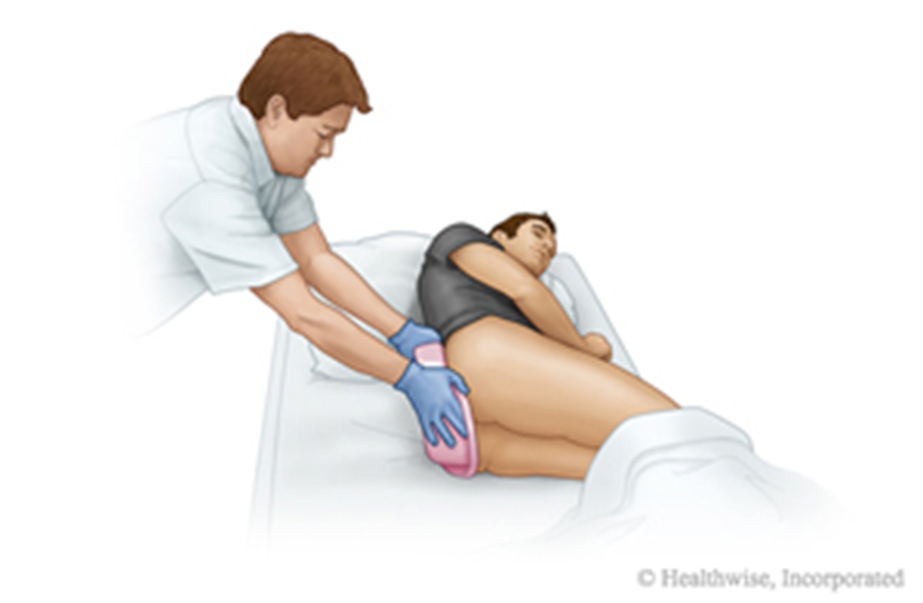Patient Data
Click to highlight the findings that indicate the client is stable for discharge.
The client has rested well throughout the night with a continuous positive airway pressure (CPAP) device in place. Sequential devices are in place for venous thromboembolism prevention. The client ambulated 100 yards (91 meters) last night and 200 yards (183 meters) this morning. She reports pain rating of 2 on 0 to 10 scale, located in the abdomen, described as aching. She has tolerated fluids throughout the night with no nausea or vomiting.
Assessment findings
Neurological Alert and oriented times 4.
Cardiovascular WNL.
Respiratory WNL.
Gastrointestinal/Genitourinary Voided twice throughout night, urine clear amber in appearance. Reports no dysuria. No bowel movement but the client is passing gas.
Integumentary 4 abdominal incisions from laparoscopic procedure sealed with surgical glue. No drainage, redness, or edema present.
Musculoskeletal Reported chronic knee pain. 5+ strength in bilateral upper extremities, 5+ strength in bilateral lower extremities.
The client ambulated 100 yards (91 meters) last night and 200 yards (183 meters) this morning
She has tolerated fluids throughout the night with no nausea or vomiting
Alert and oriented times 4
Voided twice throughout night, urine clear amber in appearance
Musculoskeletal Reported chronic knee pain
No bowel movement but the client is passing gas
Sequential devices are in place for venous thromboembolism
4 abdominal incisions from laparoscopic procedure sealed with surgical glue
The Correct Answer is ["A","B","C","D"]
The client has rested well throughout the night with a continuous positive airway pressure (CPAP) device in place. Sequential devices are in place for venous thromboembolism prevention. The client ambulated 100 yards (91 meters) last night and 200 yards (183 meters) this morning. She reports pain rating of 2 on 0 to 10 scale, located in the abdomen, described as aching. She has tolerated fluids throughout the night with no nausea or vomiting.
Assessment findings
- Neurological Alert and oriented times 4.
- Cardiovascular WNL.
- Respiratory WNL.
- Gastrointestinal/Genitourinary Voided twice throughout night, urine clear amber in appearance. Reports no dysuria. No bowel movement but the client is passing gas.
- Integumentary 4 abdominal incisions from laparoscopic procedure sealed with surgical glue. No drainage, redness, or edema present.
- Musculoskeletal Reported chronic knee pain. 5+ strength in bilateral upper extremities, 5+ strength in bilateral lower extremities.
Nursing Test Bank
Naxlex Comprehensive Predictor Exams
Related Questions
Correct Answer is {"A":{"answers":"A"},"B":{"answers":"A"},"C":{"answers":"B"},"D":{"answers":"C"},"E":{"answers":"C"}}
Explanation
Choice A Reason: A BMI of 28 kg/m² is considered overweight and is a modifiable risk factor for type 2 diabetes mellitus. Weight loss through diet and exercise can reduce the risk.
Choice B Reason: An HDL level of 43 mg/dL (1.11 mmol/L) is slightly below the recommended range and is a modifiable risk factor. Increasing HDL can be achieved through lifestyle changes such as exercise and dietary adjustments.
Choice C Reason: Having a sister with type 2 diabetes mellitus is a non-modifiable risk factor as it is related to genetic predisposition.
Choice D Reason: Occupational fume exposure is generally considered unrelated to the development of type 2 diabetes mellitus.
Choice E Reason: Cannabis use is typically unrelated to type 2 diabetes mellitus, though research on its long-term metabolic effects is ongoing.
Normal Ranges:
- BMI: 18.5 to 24.9 kg/m² (normal)
- HDL (High-Density Lipoprotein): Greater than 45 mg/dL (Greater than 1.15 mmol/L)
- LDL (Low-Density Lipoprotein): Less than 130 mg/dL (Less than 3.4 mmol/L)
- Fasting Blood Glucose: 74 to 106 mg/dL (4.1 to 5.9 mmol/L)
Correct Answer is A
Explanation
Choice A reason: Pouring warm water over the perineal area can stimulate the micturition reflex, which may help the client void. It is a non-invasive, first-line intervention to promote natural voiding in clients with urinary incontinence. The nurse should evaluate its effectiveness as it can be a simple yet effective method to assist the client.
Choice B reason: While recommending a complete bath may help maintain hygiene, it does not directly address the immediate need to stimulate voiding. The nurse's priority is to manage the incontinence issue effectively and a bath can be considered after addressing the client's immediate needs.
Choice C reason: Suggesting catheter insertion may be premature without first attempting less invasive measures. Catheterization carries risks such as infection and should be considered only when other interventions are ineffective or not feasible.
Choice D reason: There is no evidence to suggest that pouring warm water over the perineal area promotes infection in elderly females. In fact, proper perineal care is essential in preventing infections, especially in clients with incontinence.

Whether you are a student looking to ace your exams or a practicing nurse seeking to enhance your expertise , our nursing education contents will empower you with the confidence and competence to make a difference in the lives of patients and become a respected leader in the healthcare field.
Visit Naxlex, invest in your future and unlock endless possibilities with our unparalleled nursing education contents today
Report Wrong Answer on the Current Question
Do you disagree with the answer? If yes, what is your expected answer? Explain.
Kindly be descriptive with the issue you are facing.
